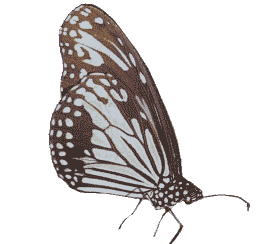
Papilio is a genus in the swallowtail butterfly family, Papilionidae, as well as the only representative of the tribe Papilionini. The word papilio is Latin for butterfly.

Graphium is a genus of mostly tropical swallowtail butterflies commonly known as swordtails, kite swallowtails, or ladies. Native to Eurasia, Africa, and Oceania, the genus is represented by over 100 species. Their colouration is as variable as the habitats they frequent; from rainforest to savannah. Some possess tails which may be long and swordlike, while others lack any hindwing extensions. Graphium species are often sighted at mud puddles.

Leptotes plinius, the zebra blue or plumbago blue, is a species of blue butterfly (Lycaenidae) found in Sri Lanka, India to Australia. The species was first described by Johan Christian Fabricius in 1793.

Celaenorrhinus is a genus of skipper butterflies which are commonly termed sprites. An alternate name is flats, for their habit of holding their wings flat when resting, but this is also used for related genera. They are the type genus of tribe Celaenorrhinini.

Red-bodied swallowtails, or ruby swallowtail (due to the color), are butterflies in the swallowtail family, that belong to the genera Atrophaneura, Byasa, Losaria, or Pachliopta. They are generally found in Asia.

Parantica, commonly called tigers, is an Old World genus of butterflies in subfamily Danainae of family Nymphalidae. They are found in southeastern Asia, Indonesia, Papua-New Guinea, and the Philippines. Many of these species are endemic to islands and considered endangered, vulnerable, or threatened according to the IUCN Red List. For other butterflies called tigers see the genus Danaus.

Mycalesis, the bushbrowns, are a genus of brush-footed butterflies. They are common in the warm regions from Central Asia to Australia, and have a high diversity in South Asia and the Wallacea.

Cyrestis thyodamas, the common map, is a species of butterfly in the family Nymphalidae. It was first described by Jean Baptiste Boisduval in 1836. It is found in the Indian subcontinent and Southeast Asia.

Neptis is a large genus of butterflies of Old World tropics and subtropics. They are commonly called sailer butterflies or sailers, or more precisely typical sailers to distinguish them from the related blue sailer (Pseudoneptis).

Cyrestis lutea, the orange straight-line map-wing or little map-wing, is a butterfly of the family Nymphalidae. It is found in Indonesia.

Cyrestis nivea, the straight-line map-wing, is a butterfly of the family Nymphalidae. It is found in South-East Asia. The habitat consists of primary and secondary forest at elevations between sea level and about 500 metres.

Euploea phaenareta, the giant crow is a butterfly in the family Nymphalidae. It was described by Johann Gottlieb Schaller in 1785. It is found in the Indomalayan realm and the Australasian realm.











